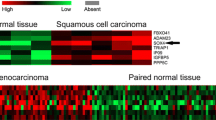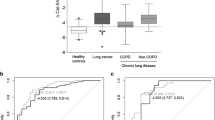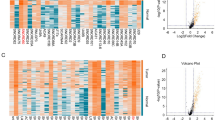Abstract
Sex-determining region Y-box 2 (SOX2), as a subunit of transcription and reprogramming factor, plays a critical role in the development and progression of many malignancies, including lung cancer through gene amplification. In the present study, we aimed to quantify the levels of serum SOX2 DNA, analyze its diagnostic value and compare it with existing clinical parameters in lung cancer, and purpose to provide a novel tumor marker for lung cancer. Serum DNA was extracted from 94 lung cancer patients, 10 benign lung diseases, and 30 healthy volunteers, and then the levels of SOX2 DNA were quantified using real-time fluorescent quantitative polymerase chain reaction (FQ-PCR). The data were analyzed by statistical software SPSS14.0. The present results show that serum SOX2 DNA level in lung cancer group was higher compared to the levels in benign lung diseases group (u = 102.0, p < 0.001) or healthy group (u = 140.0, p < 0.001), and it was closely associated with TNM stage, histopathological type, and tumor size (p = 0.031, p = 0.012, and p = 0.010, respectively). However, serum SOX2 DNA levels of lung cancer patients were not associated with age, gender, smoking status, lymph node metastasis, or tumor differentiation (p > 0.05). ROC curve showed a sensitivity of 78.9 % and a specificity of 82.5 % for the ability of serum SOX2 DNA to detect lung cancer at the cutoff value of 1,078.3 copies/ul. Furthermore, we assessed the associations of serum SOX2 levels with clinical existing lung tumor markers, such as squamous cell carcinoma antigen, cytokeratin fragment 21-1, and neuron-specific enolase. The sensitivity was increased from 24.9, 66.1, and 39.1 to 84.2, 92.8, and 87.5 %, respectively, by the combination of serum SOX2 DNA. Taken together, quantification of serum SOX2 DNA by FQ-PCR may serve as a novel accessory diagnostic tool for the clinical screening and detection of lung cancer.


Similar content being viewed by others
Abbreviations
- CAN:
-
Circulating nucleic acids
- CYFRA21-1:
-
Cytokeratin fragment 21-1
- FQ-PCR:
-
Real-time fluorescent quantitative polymerase chain reaction
- NSCLC:
-
Nonsmall cell lung cancer
- NSE:
-
Neuron-specific enolase
- SCC:
-
Squamous cell carcinoma
- SOX2:
-
Sex-determining region Y-box 2
References
Kato H, Ichinose Y, Ohta M, Hata E, Tsubota N, Tada H, Watanabe Y, Wada H, Tsuboi M, Hamajima N, Ohta M. A randomized trial of adjuvant chemotherapy with uracil-tegafur for adenocarcinoma of the lung. N Engl J Med. 2004;350:1713–21.
Jemal A, Bray F, Center MM, Ferlay J, Ward E, Forman D. Global cancer statistics. CA Cancer J Clin. 2011;61:69–90.
Bendtsen C, Kietzmann M, Korn R, Mozley PD, Schmidt G, Binnig G. X-ray computed tomography: semiautomated volumetric analysis of late-stage lung tumors as a basis for response assessments. Int J Biomed Imaging. 2011;2011:361589–600.
Lam B, Lam SY, Wong MP, Ooi CG, Fong DY, Lam DC, Lai AY, Tam CM, Pang CB, Ip MS, Lam WK. Sputum cytology examination followed by autofluorescence bronchoscopy: a practical way of identifying early stage lung cancer in central airway. Lung Cancer. 2009;64:289–94.
Leon SA, Shapiro B, Sklaroff DM, Yaros MJ. Free DNA in the serum of cancer patients and the effect of therapy. Cancer Res. 1977;37:646–50.
Schwarzenbach H, Hoon DS, Pantel K. Cell-free nucleic acids as biomarkers in cancer patients. Nat Rev Cancer. 2011;11:426–37.
Gontan C, de Munck A, Vermeij M, Grosveld F, Tibboel D, Rottier R. Sox2 is important for two crucial processes in lung development: branching morphogenesis and epithelial cell differentiation. Dev Biol. 2008;317:296–309.
Graham V, Khudyakov J, Ellis P, Pevny L. SOX2 functions to maintain neural progenitor identity. Neuron. 2003;39:749–65.
Rudin CM, Durinck S, Stawiski EW, Poirier JT, Modrusan Z, Shames DS, Bergbower EA, Guan Y, Shin J, Guillory J, Rivers CS, Foo CK, Bhatt D, Stinson J, Gnad F, Haverty PM, et al. Comprehensive genomic analysis identifies SOX2 as a frequently amplified gene in small-cell lung cancer. Nat Genet. 2012;44:1111–6.
Lengerke C, Fehm T, Kurth R, Neubauer H, Scheble V, Müller F, Schneider F, Petersen K, Wallwiener D, Kanz L, Fend F, Perner S, Bareiss PM, Staebler A. Expression of the embryonic stem cell marker SOX2 in early-stage breast carcinoma. BMC Cancer. 2011;11:42–51.
Sun C, Sun L, Li Y, Kang X, Zhang S, Liu Y. Sox2 expression predicts poor survival of hepatocellular carcinoma patients and it promotes liver cancer cell invasion by activating slug. Med Oncol. 2013;30:503–13.
Hussenet T, du Manoir S. SOX2 in squamous cell carcinoma: amplifying a pleiotropic oncogene along carcinogenesis. Cell Cycle. 2010;9:1480–6.
Hussenet T, Dali S, Exinger J, Monga B, Jost B, Dembelé D, Martinet N, Thibault C, Huelsken J, Brambilla E. du Manoir S.SOX2 is an oncogene activated by recurrent 3q26.3 amplification in human lung squamous cell carcinomas. PLoS ONE. 2010;5:e8960.
Lu Y, Futtner C, Rock JR, Xu X, Whitworth W, Hogan BL, Onaitis MW. Evidence that SOX2 overexpression is oncogenic in the lung. PLoS ONE. 2010;5:e11022.
Chen S, Xu Y, Chen Y, Li X, Mou W, Wang L, Liu Y, Reisfeld RA, Xiang R, Lv D. Li N.SOX2 gene regulates the transcriptional network of oncogenes and affects tumorigenesis of human lung cancer cells. PLoS ONE. 2012;7:e36326.
Park SB, Seo KW, So AY, Seo MS, Yu KR, Kang SK, Kang KS. SOX2 has a crucial role in the lineage determination and proliferation of mesenchymal stem cells through Dickkopf-1 and c-MYC. Cell Death Differ. 2012;19:534–45.
Tang XB, Shen XH, Li L, Zhang YF, Chen GQ. SOX2 overexpression correlates with poor prognosis in laryngeal squamous cell carcinoma. Auris Nasus Larynx. 2013;40:481–6.
Xiang R, Liao D, Cheng T, Zhou H, Shi Q, Chuang TS, Markowitz D, Reisfeld RA, Luo Y. Downregulation of transcription factor SOX2 in cancer stem cells suppresses growth and metastasis of lung cancer. Br J Cancer. 2011;104:1410–7.
Züllig L, Roessle M, Weber C, Graf N, Haerle SK, Jochum W, Stoeckli SJ, Moch H, Huber GF. High sex determining region Y-box 2 expression is a negative predictor of occult lymph node metastasis in early squamous cell carcinomas of the oral cavity. Eur J Cancer. 2013;49:1915–22.
Schröck A, Göke F, Wagner P, Bode M, Franzen A, Braun M, Huss S, Agaimy A, Ihrler S, Menon R, Kirsten R, Kristiansen G, Bootz F, Lengerke C, Perner S. Sex determining region Y-box 2 (SOX2) amplification is an independent indicator of disease recurrence in sinonasal cancer. PLoS ONE. 2013;8:e59201.
Li X, Wang J, Xu Z, Ahmad A, Li E, Wang Y, Qin S, Wang Q. Expression of Sox2 and Oct4 and their clinical significance in human non-small-cell lung cancer. Int J Mol Sci. 2012;13:7663–75.
Ginzinger DG. Gene quantification using real-time quantitative PCR: an emerging technology hits the mainstream. Exp Hematol. 2002;30:503–12.
Yang YJ, Chen H, Huang P, Li CH, Dong ZH, Hou YL. Quantification of plasma hTERT DNA in hepatocellular carcinoma patients by quantitative fluorescent polymerase chain reaction. Clin Invest Med. 2011;34:E238–44.
Travis WD, Brambilla E, Müller-Hermelink HK, Harris CC. World health organization classification tumors of the lung, pleura, thymus and heart. Lyon: IARC Press; 2004. p. 10–20.
Sasaki H, Yokota K, Hikosaka Y, Moriyama S, Yano M, Fujii Y. Increased Sox2 copy number in lung squamous cell carcinomas. ExpTher Med. 2012;3:44–8.
Tarro G, Perna A, Esposito C. Early diagnosis of lung cancer by detection of tumor liberated protein. J Cell Physiol. 2005;203:1–5.
Bass AJ, Watanabe H, Mermel CH, Yu S, Perner S, Verhaak RG, Kim SY, Wardwell L, Tamayo P, Gat-Viks I, Ramos AH, Woo MS, Weir BA, Getz G, Beroukhim R, O’Kelly M, et al. SOX2 is an amplified lineage-survival oncogene in lung and esophageal squamous cell carcinomas. Nature Genet. 2009;41:1238–42.
Wilbertz T, Wagner P, Petersen K, Stiedl AC, Scheble VJ, Maier S, Reischl M, Mikut R, Altorki NK, Moch H, Fend F, Staebler A, Bass AJ, Meyerson M, Rubin MA, Soltermann A, Lengerke C, Perner S. SOX2 gene amplification and protein overexpression are associated with better outcome in squamous cell lung cancer. Mod Pathol. 2011;24:944–53.
McCaughan F, Pole JC, Bankier AT, Konfortov BA, Carroll B, Falzon M, Rabbitts TH, George PJ, Dear PH, Rabbitts PH. Progressive 3q amplification consistently targets SOX2 in preinvasive squamous lung cancer. Am J Respir Crit Care Med. 2010;182:83–91.
Maier S, Wilbertz T, Braun M, Scheble V, Reischl M, Mikut R, Menon R, Nikolov P, Petersen K, Beschorner C, Moch H, Kakies C, Protzel C, Bauer J, Soltermann A, Fend F, Staebler A, Lengerke C, Perner S. SOX2 amplification is a common event in squamous cell carcinomas of different organ sites. Hum Pathol. 2011;42:1078–88.
Ji J, Zheng PS. Expression of Sox2 in human cervical carcinogenesis. Hum Pathol. 2010;41:1438–47.
Sozzi G, Conte D, Mariani L, Vullo SL, Roz L, Lombardo C, Pierotti MA, Tavecchio L. Analysis of circulating tumor DNA in plasma at diagnosis and during follow-up of lung cancer patients. Cancer Res. 2001;61:4675–8.
Acknowledgments
This research was supported by the Natural Science Foundation of CQ CSTC (Grant No. cstc2012jjA10105), Medical Scientific Program of Chongqing Municipal Health Bureau (Grant No. 2012-2-016), and the National Clinical Key Subject Construction Project [Grant No. 2010 (305)].
Conflict of interest
There is no conflict between the authors.
Author information
Authors and Affiliations
Corresponding author
Rights and permissions
About this article
Cite this article
Wu, Y., Du, X., Xue, C. et al. Quantification of serum SOX2 DNA with FQ-PCR potentially provides a diagnostic biomarker for lung cancer. Med Oncol 30, 737 (2013). https://doi.org/10.1007/s12032-013-0737-y
Received:
Accepted:
Published:
DOI: https://doi.org/10.1007/s12032-013-0737-y




